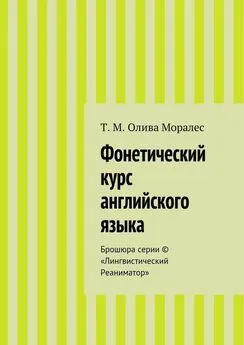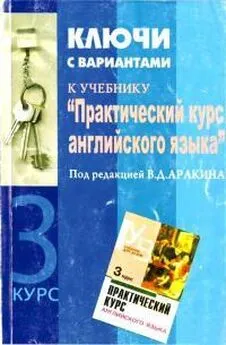Яков Аракин - Практический курс английского языка 2 курс
- Название:Практический курс английского языка 2 курс
- Автор:
- Жанр:
- Издательство:ВЛАДОС
- Год:2005
- ISBN:нет данных
- Рейтинг:
- Избранное:Добавить в избранное
-
Отзывы:
-
Ваша оценка:
Яков Аракин - Практический курс английского языка 2 курс краткое содержание
I - V курсов педагогических вузов.
Цель учебника – обучение устной речи на основе развития необходимых автоматизированных речевых навыков, развитие техники чтения, а также навыков письменной речи.
Практический курс английского языка 2 курс - читать онлайн бесплатно полную версию (весь текст целиком)
Интервал:
Закладка:
SECTION FIVE Compound Tunes FALL + RISE
7. Say the following sentences with a) the High Fall + the Low Rise; b) the Descending Head + the Low Rise. Observe the difference in attitudes:
8. Give your own replies to the Verbal Context of Ex. 1 and 6.
9. Read the following situations. Convey the attitudes suggested in brackets:
10. Listen to the dialogue on the tape ("Dinner-table Talk"). Pick out sentences containing the High Fail + the Low Rise. Say what attitude is conveyed in them. Use these sentences in conversational situations of your own.
11. Listen to the Verbal Context and express sympathy in the replies. Use the proper intonation pattern:
12. This exercise is meant to develop your ability to hear and reproduce intonation in conversation.
13. Make up conversational situations, using the following phrases:
14. Make up a dialogue about your future profession.
15. This exercise is meant to develop your ability to hear intonation and reproduce it in reading and narration.
16. This exercise is meant to test your ability to analyze and reproduce material for reading and retelling.
SECTION SIX Compound Tunes TWO OR MORE FALLS WITHIN ONE SENSE-GROUP
1. Listen carefully to the following conversational situations. Concentrate your attention on the intonation of the replies:
7. The teacher will suggest the Verbal Context of Ex. 1 and 6. The students will reply to it, using Sliding Head + High Fall. The drill continues until every student has participated. Keep the exercise moving on rapidly.
8. Listen carefully to the following conversational situations. Concentrate your attention on the intonation of the replies. Note all the prominent words of the bead:
15. Read the following sentences expressing the attitudes suggested in brackets. Use them In conversational situations of your own;
16. The teacher will suggest a Verbal Context You in turn reply to it in the form of statements and questions, expressing personal concern or interest:
17. Read the story "A Friend in Need" by S. Maugham (see p. 104). The sentences from the text given below are not true to fact. One of the students will read a sentence, another win correct him, using Intonation Patterns VI or VII.
18. Make statements to be corrected according to the model above. The drill will continue until every student has participated. Keep the exercise moving on rapidly.
19. This exercise is meant to develop your ability to bear the intonation and reproduce it in proper speech situations.
20. Make up a dialogue of your own, using phrases from the dialogue above.
21. This exercise is meant to develop your ability to hear the intonation and reproduce it in proper speech situations.
22. Read the jokes silently to make sure you understand each sentence. Find the sentence expressing the essence of each joke. Split up each sentence into intonation groups if necessary. Mark the stresses and tunes. Underline the communicative centre and the nuclear word of each intonation group. It is not expected that each student win intone the text in the same way. The teacher win help you to correct your variant. Practise reading the jokes several times:
SECTION SEVEN Intonation pattern XII I. (LOW PRE-HEAD + ) HIGH RISE (+TAIL) II. (LOW PRE-HEAD + ) (HIGH HEAD+) HIGH RISE ( + TAIL)
1. Listen carefully to the following conversational situations. Concentrate your attention on the intonation of the replies:
7. Respond to the following sentences. Use Intonation Pattern ХП casing for a repetition of the information already given.
8. This exercise is meant to develop your ability to near and reproduce intonation in different speech situations.
9. Make up conversational situations, using the following phrases:
10. Read the following dialogues. Define the communicative type of the sentences and say what attitudes you mean to convey:
11. Make up a dialogue of your own, using some of the phrases from the dialogues above.
12. Read the following sentences. The prompts in brackets will help you to determine the position of the logical stress. Make up a situation to prove the position of the logical stress:
13. Listen to the text on the tape ("Commerce and Industry"). Write it down. Mark the stresses and tunes. Practise the text.
14. Read the following sentences. Use Intonation Patters VI to single out the subject:
15. This exercise is meant to develop your ability to hear the intonation and reproduce it in proper speech situations.
16. Read the text "May Day" silently to make sure you understand each sentence. Split up each sentence into intonation groups if necessary. Mark the stresses and tones. Underline the communicative centre and the nuclear word of each intonation group. It is not expected that each student will intone the text in the same way. The teacher will help you to correct your variant
SECTION EIGHT. HIGH PRE-HEAD
1. Listen carefully to the following conversational situations. Concentrate your attention on the intonation of the replies:
2. Listen to the replies and repeat them in the intervals. Make your voice rise high when pronouncing the initial unstressed syllables.
3. Listen to the Verbal Context and reply to it in the intervals.
4. In order to fix the High Pre-Head in your mind, ear and speech habits pronounce each reply several times until it sounds perfectly natural to you.
5. Listen to a fellow-student reading the replies. Tell him (her) what his (her) errors in pronunciation are.
6. Read the drill sentences according to the given model. Concentrate your attention on the High Pre-Head:
7. Listen carefully to the following conversational situations. Concentrate your attention on the intonation of the replies:
8. Listen to the replies, and repeat them in the intervals. Make your voice rise high when pronouncing the High Pre-Head.
9. Listen to the Verbal Context and reply in the intervals.
10. In order to fix the High Pre-Head in your mind, ear and speech habits pronounce each reply several times until it sounds perfectly natural to you.
11. Listen to a fellow-student reading the replies. Tell him (her) what his (her) errors in pronunciation are.
12. Read the drill sentences according to the given model. Concentrate your attention on the High Pre-Head:
13. Listen carefully to the following conversational situations. Concentrate your attention on the intonation of the replies:
14. Listen to the replies and repeat them in the intervals. Make your voice rise high when pronouncing the High Pie-Head.
15. Listen to the Verbal Context and reply in the intervals.
16. In order to fix the High Pre-Head in your mind, ear and speech habits pronounce each reply several times until it sounds perfectly natural to you.
17. Listen to a fellow-student reading the replies. Tell him (her) what his (her) errors in pronunciation are.
18. Read the drill sentences according to the given model. Concentrate your attention on the High Pie-Head:
19. Give your own replies to the Verbal Context of Ex. 1, 6, 7, 12, 13, 18.
20. This exercise is meant to develop your ability to hear and reproduce intonation in different speech situations.
21. Read the following sentences, using intonation patterns you find suitable. Use them in conversational situations of your own:
22. This exercise is meant to develop your ability to introduce teaching material in class with correct intonation.
23. This exercise is meant to test your ability to introduce some teaching material in class with correct intonation.
24. Act as a teacher in class, using the material from the lectures above.
SUPPLEMENT
GRAMMAR EXERCISES
REVISION EXERCISES ON TENSE AND VOICE
1. a) Comment at» the use of the Present Indefinite and the Present Continuous:
b) Use the Present Indefinite or the Present Continuous instead of the infinitives in brackets:
2. Translate the sentences into English, using I hear and I am told where possible:
3. a) Comment on the Present Perfect and the Present Perfect Continuous:
b) Use the Present Perfect or the Present Perfect Continuous instead of, the infinitives in brackets:
c) Translate these sentences into Russian:
4. Use the Past Indefinite or the Present Perfect instead of the infinitives in brackets:
5. a) Comment on the Past Indefinite, the Past Continuous, the Past Perfect and the Past Perfect Continuous:
b) Use the required past tense instead of the infinitives in brackets:
6. Translate the sentences into English, paying attention to the use of tenses:
7. a) Comment on the use of the future tenses (the Future Indefinite, the Future Continuous and the Future Perfect):
b) Use the required future or present tense instead of tee infinitives in brackets where necessary:
8. Use the reguired tense instead of the infinitives in brackets:
9. Replace the Infinitives in brackets by the required tense, paying attention to the sequence of tenses:
10. Change the following from direct into indirect speech:
11. Use the required teases instead of the infinitives in brackets:
12. Think of a suitable context to use the following sentences:
13. Translate these sentences Into English:
14. Use the required tenses instead of the infinitives in brackets:
15. Comment on the use of tenses in the following sentences and translate them into Russian:
16. Use the required tenses instead of the infinitives in brackets and translate the sentences into Russian:
17. Use the required tenses instead of the infinitives in brackets and comment on their use:
I8. Pay attention to the use of the Continuous tenses. Translate the sentences into Russian:
THE SUBJUNCTIVE MOOD AND THE CONDITIONAL MOOD
19. Name the oblique moods used in the following sentences and translate the sentences into Russian:
20. Comment on the mood of the verb in the following sentences:
21. Complete the following sentences a) using the Conditional Mood;
b) using the Subjunctive Mood:
22. Supply the correct mood of the verbs in brackets:
23. Change into sentences of unreal condition:
24. Translate these sentences into English:
25. Comment on the use of the Subjunctive Mood and translate the sentences into Russian:
26. Supply the correct mood of the verbs in brackets:
27. Comment on the use of the Conditional Mood and translate the sentences into Russian:
28. Translate the sentences into English, paying attention to the use of the Conditional Mood:
29. Supply the correct mood of the verbs in brackets:
30. Translate the sentences into English paying attention to the use of the Subjunctive and the Conditional:
31. Comment on the use of the Old Present Subjunctive and translate the sentences into Russian:
MODAL VERBS
33. Comment on the form and meaning of the verb can. Translate the sentences into Russian:
34. Use the verb can in the correct form followed by the appropriate infinitive:
35. Translate Into English, using; the verb can;
36. Comment on the form and meaning of the verb may. Translate the sentences into Russsian:
37. Translate these sentences into English, using the verb may.
38. Fill in the blanks with the verbs can or may in the correct form:
39. Point out the oblique moods and modal phrases with can and may. Translate the sentences into Russian:
40. Translate these sentences into English, using can or may.
41. Comment on the meaning of the verb must. Translate the sentences into Russian;
42. Translate the following sentences Into English:
43. Change the following sentences from Active into Passive:
Читать дальшеИнтервал:
Закладка:





![Владимир Аракин - Практический курс английского языка 3 курс [calibre 2.43.0]](/books/1072035/vladimir-arakin-prakticheskij-kurs-anglijskogo-yazyk.webp)




